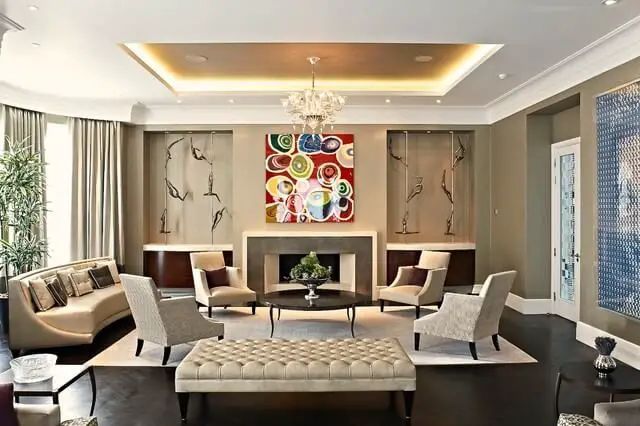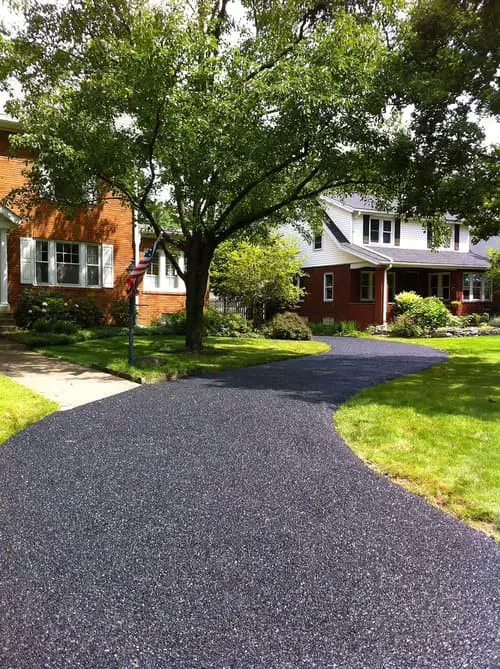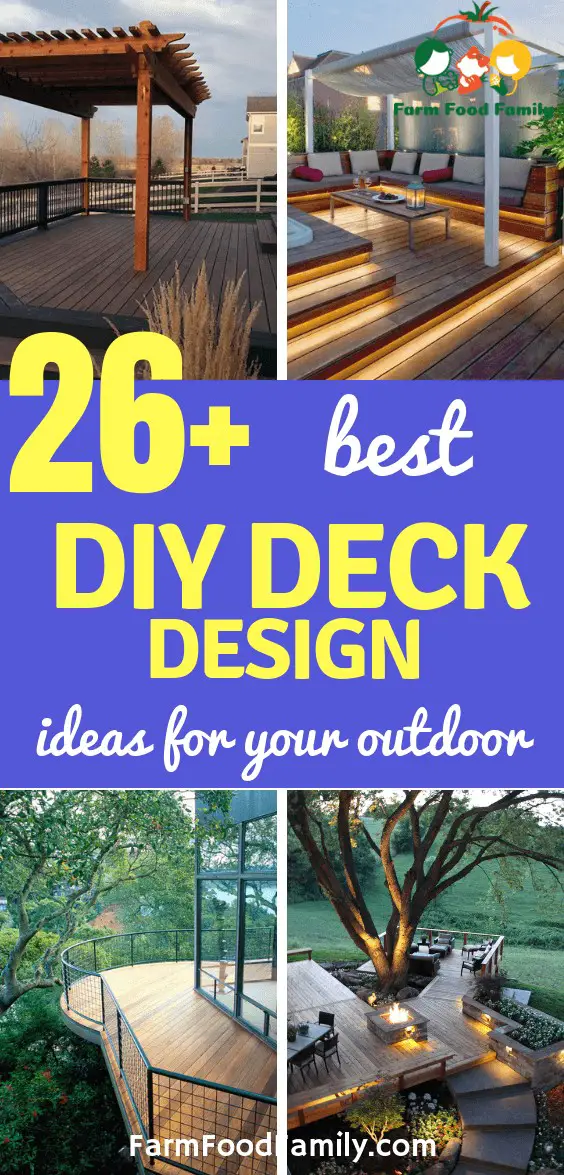25 Different Types Of Blinds And Best Materials For Window Blinds (Buying Guide)
Blinds play a multifaceted role in interior design, serving not only as aesthetic embellishments but also as functional tools for regulating light and temperature. They can help keep rooms cooler by blocking excessive sunlight during the summer months, while also allowing for subtle illumination when needed. In addition to their practical applications, blinds can also contribute to a peaceful environment, creating a dark and quiet space that fosters relaxation and a good night’s sleep.
Given the importance of choosing the right type of blind, it’s essential to understand the various options available.
In this article, we’ll delve into the most common types of blinds, providing a comprehensive overview of their characteristics, advantages, and potential drawbacks. Whether you’re in the market for new blinds or simply seeking to gain a better understanding of what’s available, this post aims to serve as a valuable resource for navigating the world of window treatments.
In terms of sheer numbers, there are numerous types of blinds out there, including Persian, Shoji, Vertical, Venetian, Mini or Micro, Panel, Pleated Shades, Cellular Shades, Sheer Shades, Roman Shades, Roller Shades, Tie-Up Shades, Solar Shades, Outdoor Shades, Skylight Shades, Smart Blinds, Blackout Roller Blinds, Day and Night Blinds, Blackout Blinds, Electric Blinds, Real Wood Blinds, Faux Wood Blinds, Conservatory Blinds, BiFold Door Blinds, and Wide Blinds.
By exploring each of these options, you’ll gain a deeper understanding of the unique characteristics that set them apart from one another.
How many types of blinds are there?

When it comes to window treatments, options can be overwhelming. From blinds to shades and shutters, each has its unique characteristics and variations. While there are numerous types of window coverings available, some stand out for their popularity or functionality. Here, we’ll focus on the most common and notable ones.
Persian blinds
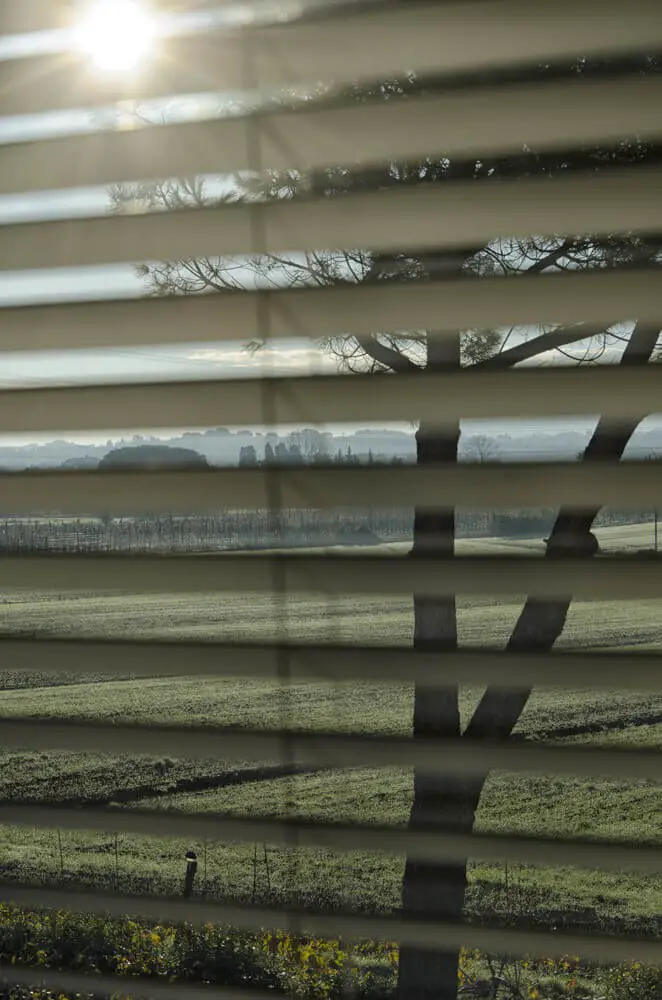
While Persian blinds may be compared to Venetian blinds due to their similar slatted design and ability to provide both privacy and light control, there’s a key distinction between the two. Unlike Venetian blinds which typically have horizontal slats, Persian blinds feature vertical slats, making them well-suited for larger sliding doors and windows.
Shoji Blinds
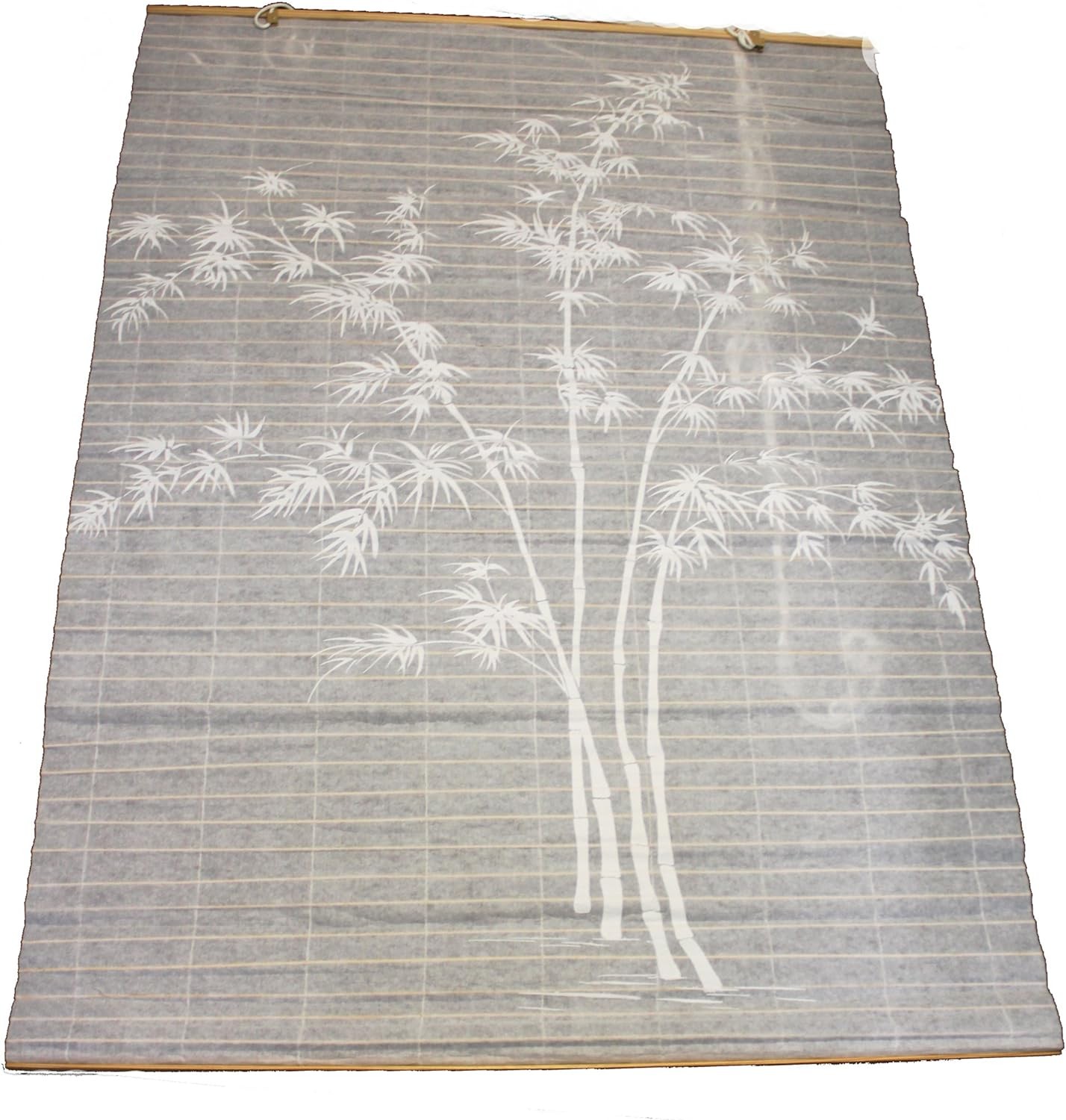
Traditional shoji blinds, originating from Japan, typically consist of rice paper, bamboo, or faux wood materials. These versatile window treatments come in two primary designs: window shade and panel track blind configurations. The window shade design resembles a bamboo floor mat installed in smaller windows, such as those found in kitchens, offering finely slatted functionality that filters in the perfect amount of natural light while maintaining privacy.
In contrast, the panel track blind design features sliding panels suitable for large windows or room dividers, providing an elegant and functional solution.
Vertical Blinds

Vertical blinds are characterized by vertical slats that run from the top of the blind to the windowsill, offering a sleek and modern look. Typically constructed from aluminum or faux wood materials, these blinds are ideal for small windows, as well as longer, taller windows and those situated high above the ceiling or by a patio.
Their customizability is also a significant benefit, allowing them to be adapted into wide blinds that can effectively cover large sliding glass doors and bi-fold door openings.
Venetian Blinds

Venetian blinds have earned their place as tried-and-true favorites, boasting horizontal slats crafted from materials such as wood, plastic, aluminum, or metal. Characterized by their cord-operated system, which simultaneously holds the slats together and allows for rolling up and tying down, these blinds are renowned for their simplicity to operate – simply unlock the slats to adjust them as desired.
Their versatility makes Venetian blinds a suitable choice for any room in the house, including kitchens where they can effectively filter light while maintaining an aesthetic appeal.
Mini or Micro Blinds

Venetian blinds have a smaller counterpart known as micro or mini blinds. These miniature versions feature slats that are only an inch or half-inch long, making them nearly imperceptible from a distance. Unlike their larger counterparts, micro blinds are crafted from fine materials such as wood, fabric, plastic, or metal. These compact blinds are designed for small windows, cozy rooms, sliding patio doors, and even bathrooms.
One notable difference is that they don’t tilt like traditional Venetian blinds; instead, they slide together seamlessly.
Panel Blinds

For those looking to harness the power of natural light, panel blinds are an excellent option. These fabric-based panels slide open and closed along a window frame, offering a seamless transition between indoors and outdoors. Unlike traditional tilting blinds, panel blinds provide an expansive view of the surrounding area when fully opened, making them particularly well-suited for patios, large windows, and glass doors.
Pleated Shades

Pleated shades, typically crafted from soft fabrics or even paper, offer a unique blend of privacy and light control by folding inward to block external views. With their affordable price point and ease of installation, they’re an ideal choice for DIY enthusiasts. Simply attach them to the window frame using a blind mount or adhesive, and you’ll be enjoying your desired level of seclusion in no time.
These shades are particularly well-suited for spaces that require ultimate privacy, such as bedrooms, bathrooms, and kitchens. Without slats to obstruct the view, they provide an unobstructed blackout effect. Plus, their minimalist design makes them a stylish addition to any room.
Cellular Shades

When it comes to window treatments on Amazon, cellular shades often get mistaken for their pleated counterparts. However, despite sharing some similarities, these two types of shades have a distinct difference. Specifically, cellular shades are characterized by front and back sections that are open in the middle, resembling honeycombs. This unique design serves as air pockets, providing enhanced room insulation.
In addition to regulating temperature during winter and summer months, cellular shades also demonstrate impressive sound-insulating properties.
Sheer Shades
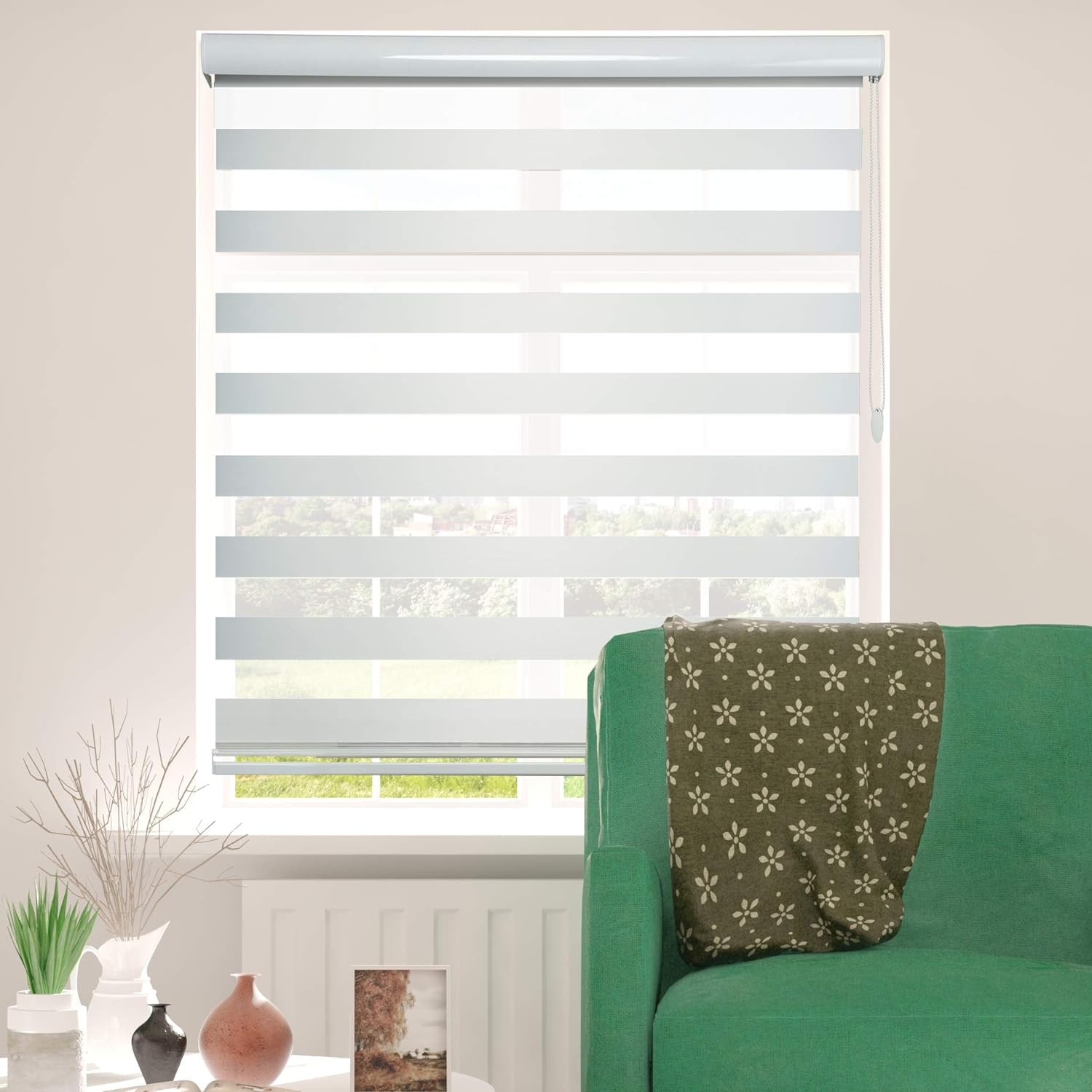
For a more extensive range of options, visit Amazon here. When it comes to sheer shades, you have a few choices depending on your desired level of illumination. If you’re looking for a soft, diffused light, traditional sheer shades are a great option. For a warmer, midday glow, consider installing traditional sheer shades with a more translucent material.
Alternatively, if you want to reduce the amount of light entering the room but still allow some natural light in, darkening sheer shades offer a great compromise.
In terms of control, sheer shades have evolved beyond traditional corded mechanisms. You can now opt for motorized control or remote-control options. Despite their delicate appearance, sheer shades are surprisingly sturdy and can be designed to mimic the look of horizontal blinds, offering a range of modern design possibilities.
Roman Shades

Roman shades are a timeless choice for window treatments, offering a unique blend of style and functionality. Unlike other popular options like Venetian blinds, Roman shades feature fabric that raises and folds into itself, creating pleat stacks when lifted. While aesthetically pleasing, the stacked pleats can affect the room’s visual flow. To address this, modern Roman shades often incorporate thermal linings for improved insulation and blackout linings for enhanced privacy and light control.
Roller Shades

While Amazon may be a popular destination, another window treatment has gained widespread acclaim – roller shades! Similar to roman shades, they can be crafted from fabric and offer versatility in terms of mounting options. Additionally, roller shades can be paired with various accessories like cornices, fascia, and valances for a customized look. Like their roman shade counterparts, roller shades also come with the option of blackout and thermal linings for enhanced functionality.
Also known as diner shades, these designs boast larger horizontal slats that provide better insulation and greater control over the amount of light entering the room. Today’s roller shades can be operated using cords or have evolved to feature motorized systems, offering users a range of options to suit their preferences.
Tie-Up Shades
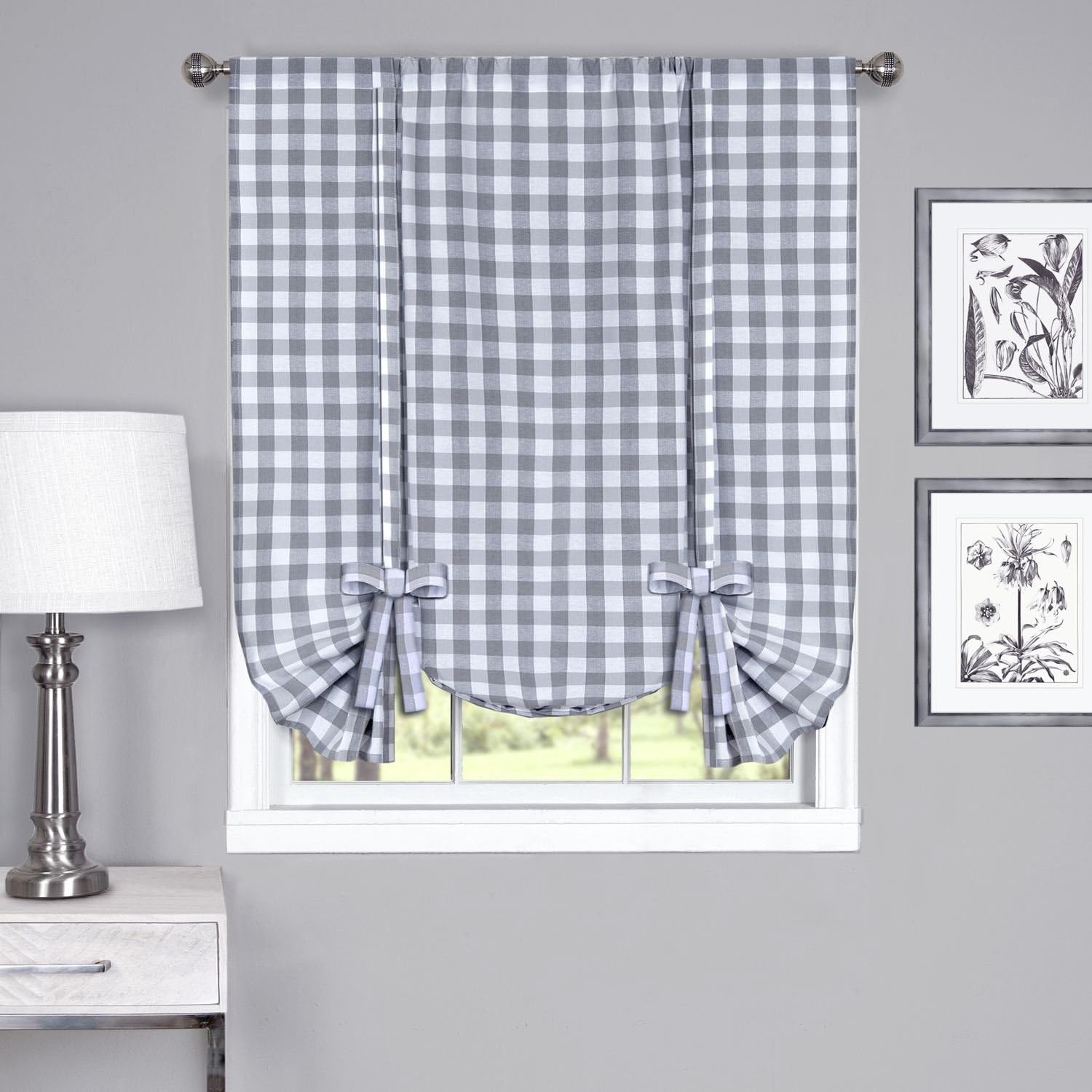
Amazon links: [Learn More](https://www.example.com)The intersection of curtains and shades, this innovative product combines the natural beauty of fabric with synthetic materials. Its unique design resembles a curtain with a bottom tie that allows for effortless rolling up. Although some tying is required post-use, the Country style tie-up shade remains the most sought-after variant in window treatment circles.
Solar Shades

For a seamless blend of indoor and outdoor living, consider these versatile shades. Engineered to balance natural light with UV protection, they allow for unobstructed views while filtering out harsh rays. Suitable for interior applications, they can also be used as smaller exterior shades. Constructed from lightweight, woven polyethylene materials, their office-inspired aesthetic may not be the first choice for homeowners seeking a stylish touch.
Moreover, customization options are limited, making them an unconventional yet functional solution for specific spaces.
Outdoor Shades
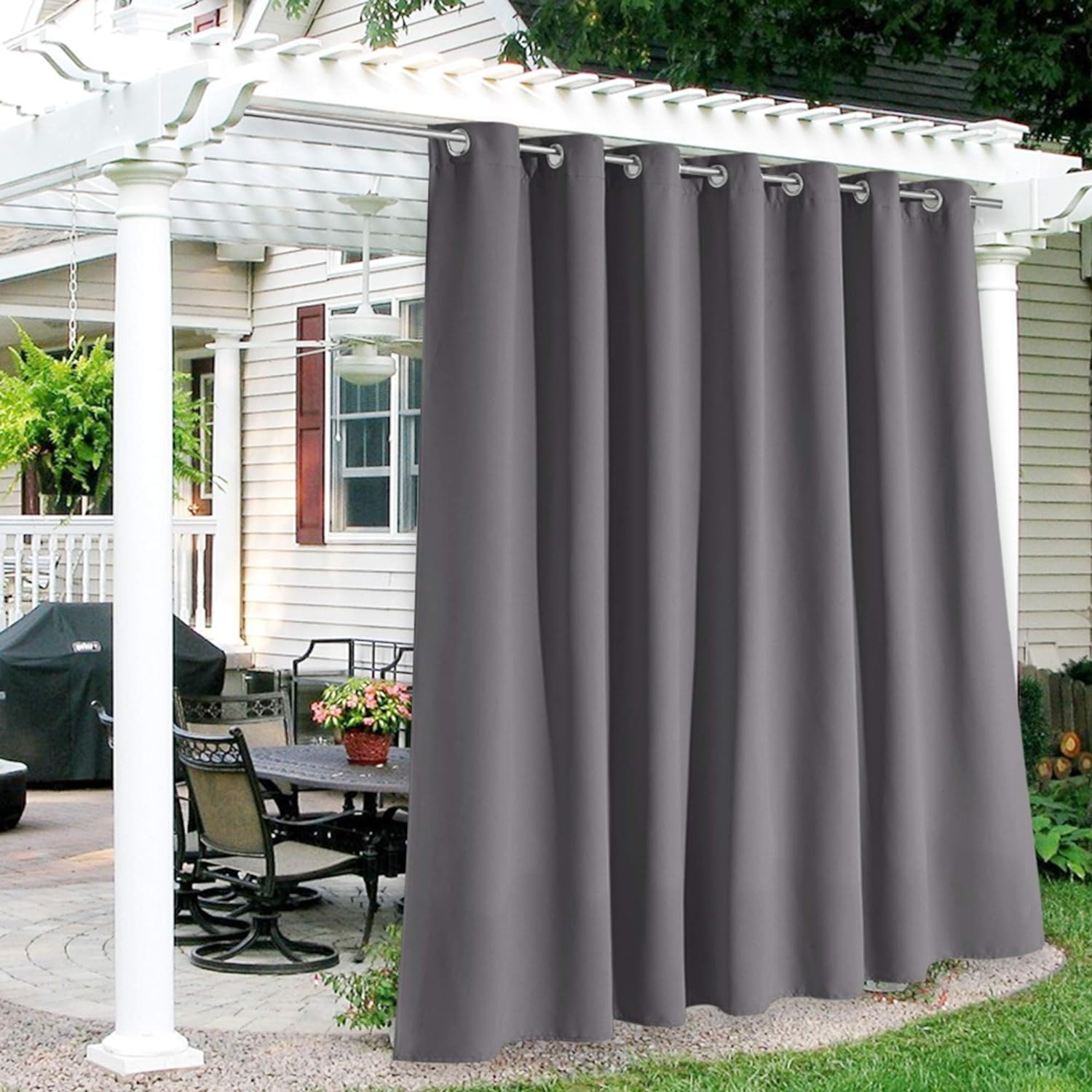
For homeowners looking to enhance their outdoor living spaces, a waterproof shade installed in the home’s barbecue area or on the patio is an excellent option. Typically constructed from durable materials such as reeds, woven wood, or wood grain, these shades can withstand harsh weather conditions and other environmental elements.
Unlike traditional metal screens with larger slats, these finer mesh shades offer improved functionality by allowing a gentle breeze to enter during hot summer months, regulating light while still providing an unobstructed view. Furthermore, they can be easily rolled down during rainy seasons, offering a seamless transition between indoor and outdoor living.
Skylight Shades

When shopping for skylight shades, you can opt for cellular, pleated, or roller styles. Among these options, cellular shades stand out as the most popular choice due to their exceptional insulation capabilities. These shades are designed specifically for covering skylights in the attic and can be rolled up and pulled down using a stick or rod.
In recent years, modern designs have evolved to include automatic skylight shades that can be operated with the touch of a small button, replacing traditional cords.
Smart Blinds

As we continue to explore the world of smart home technology, it’s no surprise that smart blinds have also emerged as a convenient and innovative solution for homeowners. While traditional designs are still available, the real excitement lies in the high-tech versions that bring a new level of control and customization to your window treatments. With a phone application, you can easily operate each panel or all of them at once, giving you total command over your home’s windows.
Additionally, scheduling features allow you to program specific times for opening and closing, ensuring a consistent look and feel throughout the day. And the best part? You don’t have to replace your existing blinds entirely – simply purchase remotes that can retrofit your current setup, making it an affordable option in the long run.
Blackout Roller Blinds
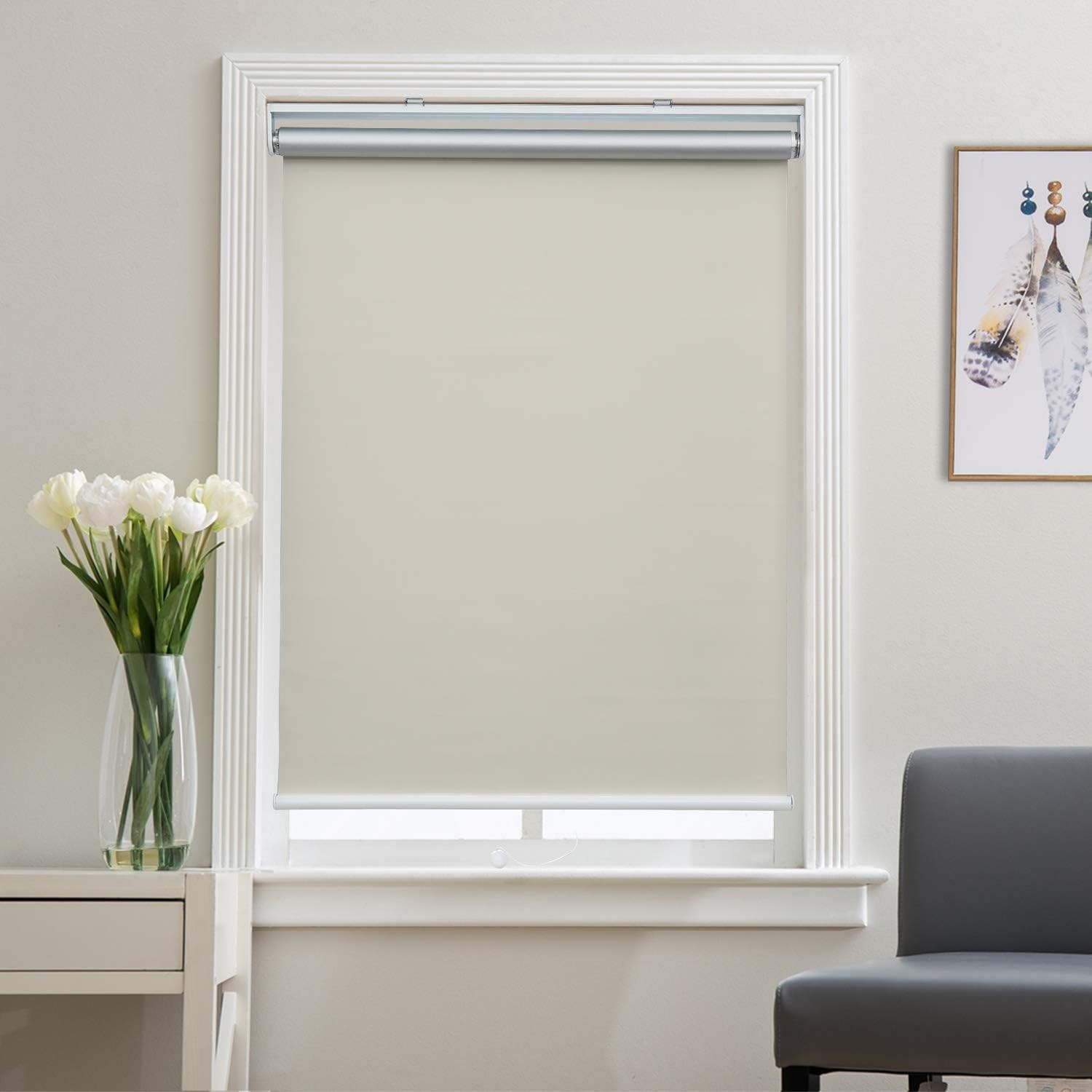
For enhanced privacy and light control, especially in bedrooms, consider upgrading your existing roller blinds with a blackout lining or fabric. These easy-to-install solutions can be clipped onto the top rod of your current blinds, ensuring a seamless fit and complete elimination of unwanted light intrusion.
Blackout linings are available in plain or patterned designs and boast thicker, opaque fabrics that provide unparalleled insulation from external light sources.
With this simple yet effective solution, you can enjoy a peaceful night’s sleep and wake up feeling refreshed.
Day and Night Blinds

For optimal privacy, sound insulation, and light control, consider incorporating day and night blinds into your room design. These versatile window treatments are particularly effective in rooms facing busy roads or noisy areas, as they can be relied upon to block out distractions during the day and at night. Beyond their functional benefits, day and night blinds also offer a sleek aesthetic appeal.
Their construction typically involves combining opaque fabric panels with adjustable sheer fabric, featuring a cord on the side for easy operation. When you pull the cord down, the slat gaps close, mimicking the appearance of blockout blinds. Meanwhile, the cord allows you to regulate the amount of light that enters the room, providing a high degree of control over your indoor environment.
Blackout Blinds

For ultimate privacy and comfort, blackout blinds stand out as top choices. Not only do they effectively block out light, but they also excel at reducing outside noise levels. Additionally, their thermal linings provide excellent room insulation throughout the year. With a range of styles and variants available, including blockout roller blinds that forgo slats in favor of strong synthetic and natural fabrics.
Electric Blinds
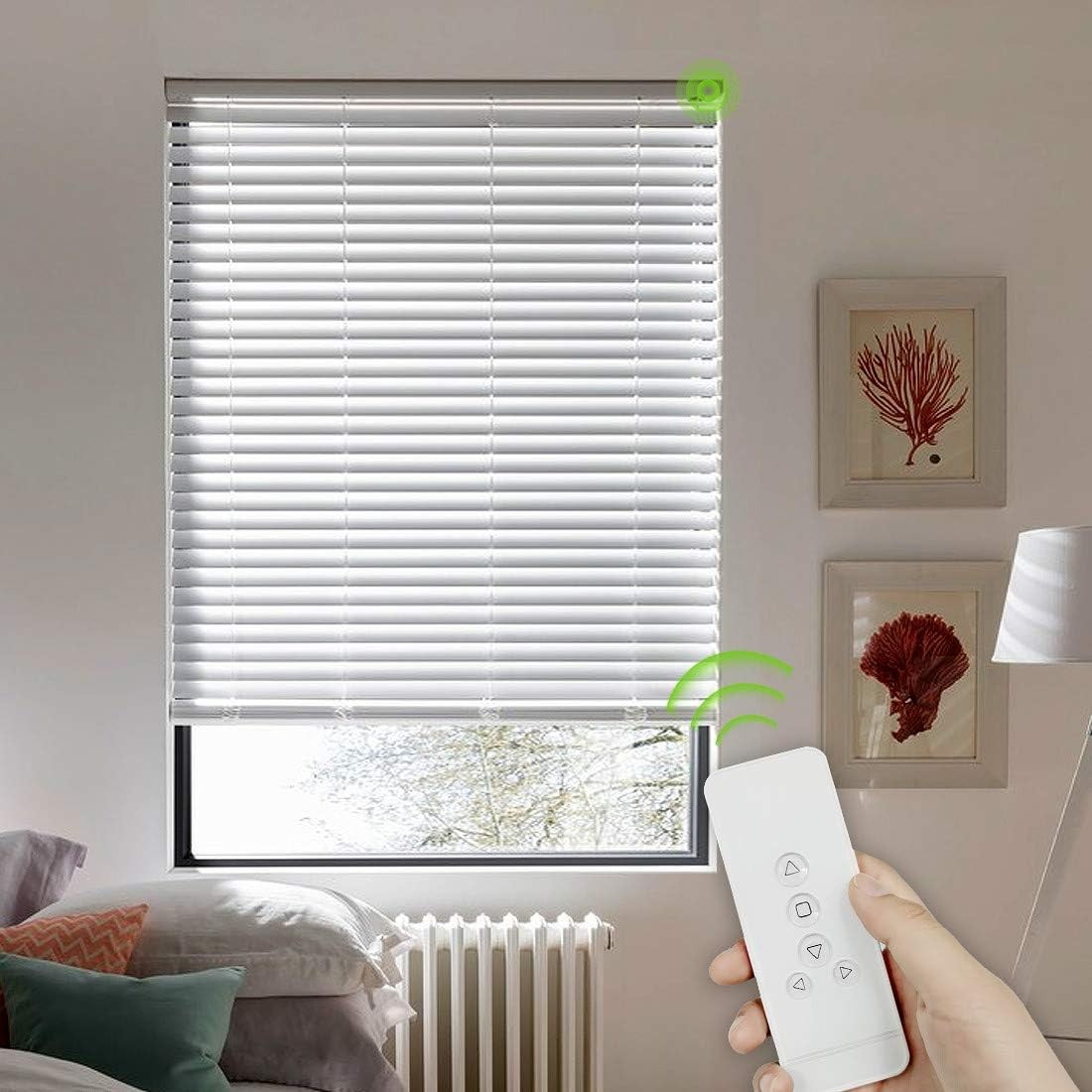
Discover the benefits of motorized blinds on Amazon by clicking here to learn more. Initially, they may seem pricey, but their cost-efficiency in the long run is undeniable. One of the key features that sets them apart is the energy-saving potential, courtesy of motorized buttons that allow you to adjust slat gaps for optimal light control or complete blackout mode. With a simple one-button operation, these blinds can be effortlessly raised and lowered vertically or horizontally.
Powered by reliable lithium batteries, which are designed to last at least five years, you can enjoy the convenience and peace of mind that comes with knowing your investment is well worth it.
Real Wood Blinds

Real wood blinds offer a unique blend of aesthetics and functionality, crafted from genuine timber and finished with various stains and paints to harmonize with the interior design of a home. A key distinction from faux wood alternatives is that real wood blinds are remarkably lightweight, making them an ideal choice for large windows.
However, it’s essential to consider the installation location, as wood can warp or crack when exposed to moisture, rendering them unsuitable for high-humidity areas like bathrooms or kitchens. Despite being more expensive than their synthetic counterparts, real wood blinds are renowned for their durability and can be relied upon to endure for at least a decade.
Faux Wood Blinds

Faux wood blinds have gained popularity over real wood blinds due to their unique characteristics. Unlike genuine wood blinds that are prone to cracking, warping, or splitting, faux wood blinds are remarkably resilient. This durability is just one of the many advantages they offer. As an added benefit, they’re also cost-effective and resistant to scratches on the surface.
Furthermore, their PVC vinyl and composite wood composition makes them easy to clean, highly customizable, and well-suited for environments with high humidity or moisture.
Conservatory Blinds

For glass ceilings, a roof blind is an excellent option. Not only do they offer shade and air circulation, but they also provide light control. With such a wide range of choices available, you can easily customize your blinds to suit your conservatory’s unique style.
Among the most popular options are Roman blinds, which combine sophistication with classic charm; Venetian blinds, renowned for their anti-glare properties and ability to regulate light; and vertical blinds, perfect for maintaining good airflow.
BiFold Door Blinds

BiFold blinds are specifically designed for installation on BiFold doors or panels, offering a seamless fit. Their simplicity makes them an attractive option, as they can be easily clipped into place. These blinds provide exceptional privacy and light control solutions for sliding glass doors and windows. One of the key advantages is their ability to accurately follow the frame of sliding doors, eliminating the need for flaps that can compromise the overall aesthetic.
The finely slatted design allows only small amounts of light to filter through, providing a high level of customization. Additionally, BiFold door blinds are available in various styles, including roller blinds, pleated blinds, and Venetian blinds. Their ease of cleaning and child-safety features make them an ideal choice for homeowners seeking a practical and effective solution.
Wide Blinds

While using two or three blinds for a very large window can be a viable option, it’s essential to consider the potential issues with fitting and light control. Unmeasured gaps between joined blinds can lead to inconsistent shading, making it crucial to choose wide blinds instead. Wide blinds are custom-made, typically vertical or roller-style, designed to accommodate non-standard window lengths and widths.
They’re ideal for floor-to-ceiling windows or large designs that prioritize both privacy and light control with a single blind.
Window Blind Materials
When it comes to blinds, the choice of material plays a significant role in determining their quality and functionality. Blind materials fall into seven categories, each with its unique characteristics. These categories include aluminum, leather, fabric, wood, vinyl, bamboo, and faux wood. Aluminum is an affordable option that offers lightweight and easy-to-clean properties. Although it may be prone to bending, it’s a popular choice for Venetian blinds.
Leather, on the other hand, provides a distinctive look for Venetian blinds but comes at a higher cost. It offers sturdier slats compared to aluminum. Fabric is another budget-friendly option that can be constructed as one piece without separate slats. This type of blind is commonly used as blackout linings and features common fabrics like silk, wool, polyester, and cotton. Wood is a classic choice that’s both expensive and versatile.
Its natural strength makes it easy to maintain and resistant to bending. It’s an ideal material for traditional and rustic designs. Vinyl is another affordable option that offers ease of cleaning and a timeless look. Bamboo is an eco-friendly choice that provides sturdiness, durability, and resistance to humid environments. It’s perfect for insulation purposes. Faux wood, as the name suggests, mimics the properties of real wood but at a lower cost.
It’s easy to maintain, withstands moisture and humidity, and resists warping, cracking, or bending. This versatile material offers the best of both worlds – the elegance of wood and the affordability of vinyl.
Blinds vs Shades
When it comes to window treatments, the choice between blinds and shades can be a daunting one. But what’s often overlooked is the fact that these two terms actually refer to distinct types of window coverings. Both blinds and shades serve the same purpose – adding privacy and regulating the amount of light that enters a room.
Blinds typically describe any structured window covering with slats that can be adjusted by tilting them.
These slats may run horizontally or vertically, and are often made from materials such as vinyl, aluminum, bamboo, woven wood, and faux wood.
On the other hand, shades refer to solid window coverings crafted from softer materials like fabric or synthetic fibers. Roller shades and roman shades are two of the most popular types of shades.
Sometimes, blinds and shades are combined and installed together as a single window treatment.
In this setup, shades are typically draped over blinds to provide thermal or blackout lining. Thermal lining shades are often made from sheer fabrics like cotton or polyester, while blockout lining shades are thicker and more opaque, crafted from materials like leather, wool, or polyester.
Blinds Buyer’s Guide
When it comes to purchasing blinds, there are several factors to take into account, even if you’re new to the process. To ensure you make an informed decision and avoid any potential pitfalls, consider the following key points as you shop for your ideal set of blinds.
Materials and energy-saving properties
When selecting materials for your blinds, it’s essential to consider the climate of your location. For instance, outdoor blinds are ideal for areas with high humidity levels, whereas wooden blinds may be a better choice for cooler climates. In terms of energy efficiency, blinds can be a cost-effective way to insulate your home. To maximize their effectiveness as an insulator, choose blinds that will effectively retain heat during winter and reflect light and heat during summer.
Purpose
When considering blinds for your home, there are two primary objectives to keep in mind: enhancing the property’s visual appeal and increasing its functional value. To determine which direction to take, reflect on your lifestyle and what you want to achieve with your blind selection. If you’re looking to add a touch of style, materials like faux wood, fabric, and leather might be the way to go.
On the other hand, if functionality is your top priority, options such as aluminum, bamboo, and wood could be the best fit for your needs.
Privacy and light control
Blinds are primarily designed to manage light levels and ensure privacy. When it comes to blocking intense sunlight during peak hours, materials like aluminum, leather, bamboo, or wood are ideal for this purpose. On the other hand, if you prefer to maintain some level of natural light while still maintaining a degree of seclusion, fabric blinds or faux wood options can provide the perfect balance.
Safety features
For households with young children who love to play, traditional blinds with lift cords can pose a safety risk. To mitigate this hazard, consider opting for cordless or motorized blinds instead. These alternatives feature user-friendly open and close buttons that eliminate the need for dangling cords, making them a safer choice for families.
Style
When it comes to harmonizing the colors of your home with its interior decorations, a crucial aspect is choosing the right shades for your blinds. For homes with neutral tones, introducing subtle or warm-colored blinds can elevate the overall aesthetic appeal. On the other hand, if you have pastel-hued interiors and wish to inject more vibrancy, opting for deeper or brighter-hued blinds can create a stunning contrast that adds depth and visual interest.
By making informed decisions about your blind colors, you can strike the perfect balance between style and functionality, ultimately transforming your living space into a haven of comfort and beauty.
Budget
While blinds may generally offer a more affordable option compared to shades, it’s crucial to recognize that premium blind options do exist. For instance, aluminum blinds are often the most economical choice, with installation costs ranging from $350 to $700 for 8 windows. On the other hand, faux wood and wood blinds tend to be pricier, falling within the $400 to $850 range. Furthermore, it’s worth noting that larger blinds typically come with a higher price tag.
If you’re considering customized blinds and have an unlimited budget, feel free to go for it. However, if budget is a concern, there are still plenty of design options available in malls.
FAQs
When selecting blinds for your home, it’s not just about knowing the different types available; you also need to consider factors like location-specific suitability and popularity trends. To make an informed decision, it’s essential to address common queries. For instance, what type of blind is most suited for a particular room or area? Which design style is currently in vogue among homeowners?
By considering these questions and more, you’ll be able to pinpoint the perfect solution for your unique needs.
What types of blinds are best for bedrooms?
When it comes to choosing the perfect blinds for your bedroom, five types stand out from the rest. If you’re looking for a room with complete darkness, blockout blinds are the way to go. Not only do they effectively shut out light, but they also provide excellent insulation and can help regulate the temperature in your room. Duette blinds are another great option if you want to keep light from creeping in through the sides of your window.
Roman blinds with blackout linings offer a similar solution, creating a cozy atmosphere that’s perfect for sleeping or relaxing. For a balanced approach that allows some natural light in while still maintaining some level of darkness, vertical blinds and Venetian blinds are excellent choices.
Which blinds are best for the kitchen?
When it comes to choosing the best blinds for your kitchen, there are several options to consider. For energy efficiency and added insulation, cellular blinds can provide a great solution. Alternatively, roman blinds offer a classic look while filtering light, making them a popular choice. If you’re looking for something more modern and versatile, sheer shades could be the way to go.
For privacy purposes and to add some warmth to your kitchen’s industrial feel, bamboo or faux wood blinds can be a great option. These materials can help soften the space and provide a cozy atmosphere. Woven wood blinds also offer a natural look that can complement a variety of kitchen styles.
How do I choose the right size blinds?
To determine the ideal size of blinds for each window, follow these steps: Start by measuring the width within the window’s opening from top to bottom and at its center. Record the shortest measurement among the three and round it down to the nearest 1/8 inch. For the length, measure the distance from the window’s opening to the sill at the center, left, and right sides. Take the longest measurement and subtract 0.25 inches to ensure the blinds sit comfortably on the sill.
Finally, take diagonal measurements to check for any significant gaps. If the results show notable discrepancies, an outside mount installation may be necessary.
What are the most modern blinds?
The modern blinds sector has undergone significant upgrades, incorporating features that prioritize energy efficiency, enhanced privacy, and sleek designs. Ergonomic controls and customization options have also become increasingly important. Among the most cutting-edge blinds are: embossed vertical blinds, polyester blinds, zebra roller blinds/shades, cordless magnetic blinds/shades, and cordless wood blinds/shades.
Additionally, cordless window and floor mount blinds as well as customized solutions like wide blinds and thermal blinds have gained popularity.
What are the most popular window blinds?
Today, a mix of old and new favorites can be found in the world of window blinds. While some styles have remained consistently popular over time, others have emerged as modern alternatives to traditional options. Currently, the most sought-after types of blinds include Roman shades and woven wood blinds, which offer a natural, rustic charm. Wood and aluminum shutters remain a timeless choice for those seeking a classic look.
Faux wood blinds provide an affordable alternative to real wood, while cordless blinds have gained popularity for their ease of use. Venetian blinds also continue to be a popular selection, offering a sleek and sophisticated appearance.
Conclusion
Window treatments have become an integral part of a home’s interior design, serving both aesthetic and functional purposes. Beyond their initial roles in providing privacy, enhancing visuals, and regulating light, modern window treatments have evolved to prioritize energy efficiency and insulation. The rise of cordless blinds has further contributed to their widespread appeal. As the various types of blinds continue to thrive, it’s clear they’re here to stay.
If you’re considering installing one soon, this comprehensive guide will equip you with all the knowledge you need to make an informed decision.
Related Posts
When it comes to building or upgrading a home, selecting the right materials for windows and doors can make all the difference. Steel-framed options, in particular, offer numerous benefits that set them apart from other choices. For instance, steel is incredibly durable, resistant to warping, and can withstand harsh weather conditions without compromising performance. This makes it an excellent choice for homeowners who value strength and longevity in their exterior openings.
Furthermore, steel frames can be designed with a variety of finishes and styles, allowing homeowners to customize the look and feel of their windows and doors to suit their unique tastes and architectural preferences.


